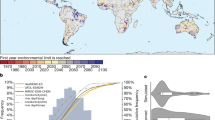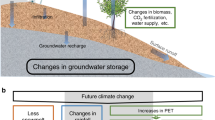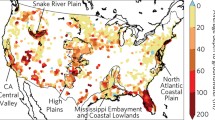Abstract
Since surface water and groundwater systems are fully coupled and integrated, increased groundwater withdrawal during drought may reduce groundwater discharges into the stream, thereby prolonging both systems’ recovery from drought. To analyze watershed response to basin-level groundwater pumping, we propose a modelling framework to understand the resiliency of surface water and groundwater systems using an integrated hydrologic model under transient pumping. The proposed framework incorporates uncertainties in initial conditions to develop robust estimates of restoration times of both surface water and groundwater and quantifies how pumping impacts state variables such as soil moisture. Groundwater pumping impacts over a watershed were also analyzed under different pumping volumes and different potential climate scenarios. Our analyses show that groundwater restoration time is more sensitive to variability in climate forcings as opposed to changes in pumping volumes. After the cessation of pumping, streamflow recovers quickly in comparison to groundwater, which has higher persistence. Pumping impacts on various hydrologic variables were also discussed. Potential for developing optimal conjunctive management plans using seasonal-to-interannual climate forecasts is also discussed.











Similar content being viewed by others
Data availability
Gridded observed precipitation and temperature data are available at Ed Maurer’s webpage (http://www.engr.scu.edu/~emaurer/gridded_obs/index_gridded_obs.html). Streamflow and groundwater depth data for the target basins are available at USGS Water Data webpage (http://waterdata.usgs.gov/nwis). For watershed data sets—watershed boundary shape files, terrain data on digital elevation, land cover classification data—are available at the USGS national map viewer and download platform (http://nationalmap.gov/viewer.html).
References
Alley WM (2009) Groundwater. In: Likens GE (ed) Encyclopedia of inland waters (vol 1). Academic, London
Barlow PM, Leake SA (2012) Streamflow depletion by wells—understanding and managing the effects of groundwater pumping on streamflow. U.S. Geological Survey Circular 1376, p 84
Bhatt G, Kumar M, Duffy CJ (2014) A tightly coupled GIS and distributed hydrologic modeling framework. Environ Model Softw 62:70–84. https://doi.org/10.1016/j.envsoft.2014.08.003
Chen X, Kumar M, McGlynn BL (2015) Variations in streamflow response to large hurricane-season storms in a southeastern U.S. watersshed. J Hydrometeorol 15:55–69. https://doi.org/10.1175/JHM-D-14-0044.1
Condon L, Maxwell R (2014) Feedbacks between managed irrigation and water availability: diagnosing temporal and spatial patterns using an integrated hydrologic model. Water Resour Res. https://doi.org/10.1002/2013WR014868
Daniel CC (1989) Statistical analysis relating well yield to construction practices and siting of wells in the Piedmont and Blue Ridge Provinces of North Carolina. USGPO; for sale by the books and open-file reports section, US Geological Survey
Devineni N, Sankarasubramanian A (2010a) Improved categorical winter precipitation forecasts through multimodel combinations of coupled GCMs. Geophys Res Lett 37:L24704. https://doi.org/10.1029/2010GL044989
Devineni N, Sankarasubramanian A (2010b) Improving the prediction of winter precipitation and temperature over the continental United States: role of the ENSO state in developing multimodel combinations. Mon Weather Rev 138(6):2447–2468
Draper C (2015) California’s excessive pumping during drought could permanently destroy aquifers. Glitch News. http://www.glitch.news/2015-09-15-californias-excessive-pumping-during-drought-could-permanently-destroy-aquifers.html. Retrieved on 15 May 2016.
Filimonova EA, Shtengelov RS (2013) The dependence of stream depletion by seasonal pumping on various hydraulic characteristics and engineering factors. Hydrogeol J 21(8):1821–1832. https://doi.org/10.1007/s10040-013-1053-5
Fry J, Xian G, Jin S, Dewitz J, Homer C, Yang L, Barnes C, Herold N, Wickham J (2011) Completion of the 2006 national land cover database for the conterminous United States. Photogramm Eng Remote Sens 77(9):858–864
Garner BD, Pool DR, Tillman FD, Forbes BT (2013) Human effects on the hydrologic system of the Verde Valley, Central Arizona, 1910–2005 and 2005–2110, using a regional groundwater flow model. U.S. Geological Survey Scientific Investigations Report 2013-5029
Gleeson T, Wada Y, Bierkens MFP, van Beek LPH (2012) Water balance of global aquifers revealed by groundwater footprint. Nature 488(7410):197–200. https://doi.org/10.1038/nature11295
Harbaugh AW (2005) MODFLOW-2005, the U.S. Geological Survey modular ground-water model—the ground-water flow process: U.S. Geological Survey Techniques and Methods, pp 6-A16
Heath RC (1984) Ground-water regions of the United States. US Government Printing Office, Washington, DC, p 78
Kendy E, Bredehoeft JD (2006) Transient effects of groundwater pumping and surface-water-irrigation returns on streamflow. Water Resour Res 42:1–11. https://doi.org/10.1029/2005WR004792
Kenny JF, Barber NL, Hutson SS, Linsey KS, Lovelace JK, Maupin MA (2009) Estimated use of water in the United States in 2005: U.S. Geological Survey Circular 1344, p 52
Kollet SJ, Maxwell RM (2008) Capturing the influence of groundwater dynamics on land surface processes using an integrated, distributed watershed model. Water Resour Res. https://doi.org/10.1029/2007wr006004
Konikow LF, Leake SA (2014) Depletion and capture: revisiting “The Source of Water Derived from Wells”. Groundwater 52(S1):100–111. https://doi.org/10.1111/gwat.12204
Kumar M, Duffy CJ (2015) Exploring the role of domain partitioning on efficiency of parallel distributed hydrologic model simulations. J Hydrogeol Hydrol Eng 4(1):1–12
Kumar M, Bhatt G, Duffy CJ (2009a) An efficient domain decomposition framework for accurate representation of geodata in distributed hydrologic models. Int J Geogr Inf Sci 23(12):1569–1596
Kumar M, Duffy CJ, Salvage KM (2009b) A second-order accurate, finite volume-based, integrated hydrologic modeling (FIHM) framework for simulation of surface and subsurface flow. Vadose Zone J 8(4):873. https://doi.org/10.2136/vzj2009.0014
Leake SA, Pool DR (2010) Simulated effects of groundwater pumping and artificial recharge on surface-water resources and riparian vegetation in the Verde Valley sub-basin, Central Arizona
Li W, Sankarasubramanian A (2012) Reducing hydrologic model uncertainty in monthly streamflow predictions using multimodel combination. Water Resour Res 48:W12516. https://doi.org/10.1029/2011WR011380
Li H, Luo L, Wood EF, Schaake J (2009) The role of initial conditions and forcing uncertainties in seasonal hydrologic forecasting. J Geophys Res Atmos 114(4):1–10. https://doi.org/10.1029/2008JD010969
Li W, Sankarasubramanian A, Ranjithan RS, Sinha T (2016) Role of multimodel combination and data assimilation in improving streamflow prediction over multiple time scales. Stoch Environ Res Risk Assess 30:2255. https://doi.org/10.1007/s00477-015-1158-6
Lin H-T, Ke K-Y, Tan Y-C, Wu S-C, Hsu G, Chen P-C, Fang S-T (2013) Estimating pumping rates and identifying potential recharge zones for groundwater management in multi-aquifers system. Water Resour Manag 27(9):3293–3306. https://doi.org/10.1007/s11269-013-0347-7
Lindsey BBD, Falls WF, Ferrari MJ, Zimmerman TM, Harned DA, Sadorf EM, Chapman MJ (2006) Factors affecting occurrence and distribution of selected contaminants in ground water from selected areas in the Piedmont Aquifer System, Eastern United States, 1993–2003
Lustgarten A (2015) Despite decades of accepted science, California and Arizona are still miscounting their water supplies. ProPublica. https://projects.propublica.org/killing-the-colorado/story/groundwater-drought-california-arizona-miscounting-water. Retrieved on 15 May 2016.
Maurer EP, Wood AW, Adam JC, Lettenmaier DP, Nijssen B (2002) A long-term hydrologically based dataset of land surface fluxes and states for the conterminous United States. J Clim 15(22):3237–3251
Moradkhani H, Hsu KL, Gupta H, Sorooshian S (2005) Uncertainty assessment of hydrologic model states and parameters: sequential data assimilation using the particle filter. Water Resour Res. https://doi.org/10.1029/2004WR003604
Mueller FA, Male JW (1993) A management model for specification of groundwater withdrawal permits. Eng Fac Publ Present. https://doi.org/10.1029/92WR02908
Qu Y, Duffy CJ (2007) A semidiscrete finite volume formulation for multiprocess watershed simulation. Water Resour Res. https://doi.org/10.1029/2006WR005752
Rasmussen TC, Haborak KG, Young MH (2003) Estimating aquifer hydraulic properties using sinusoidal pumping at the Savannah River Site, South Carolina, USA. Hydrogeol J 11:466–482
Sankarasubramanian A, Vogel RM (2002) Annual hydroclimatology of the United States. Water Resour Res. https://doi.org/10.1029/2001wr000619 (art.no.1083)
Sankarasubramanian A, Sabo JL, Larson KL, Seo SB, Sinha T, Bhowmik R, Vidal AR, Kunkel K, Mahinthakumar G, Berglund EZ, Kominoski J (2017) Synthesis of public water supply use in the U.S.: spatio-temporal patterns and socio-economic controls. Earth’s Future. https://doi.org/10.1002/2016ef000511
Scibek J, Allen DM, Cannon AJ, Whitfield PH (2007) Groundwater–surface water interaction under scenarios of climate change using a high-resolution transient groundwater model. J Hydrol 333(2–4):165–181. https://doi.org/10.1016/j.jhydrol.2006.08.005
Seo SB, Sinha T, Mahinthakumar K, Sankarasubramanian A, Kumar M (2016) Identification of dominant source of errors in developing streamflow and groundwater projection under near-term climate change. J Geophys Res Atmos. https://doi.org/10.1002/2016jd025138
Shi Y, Davis KJ, Duffy CJ, Yu H (2013) Development of a coupled land surface hydrologic model and evaluation at a critical zone observatory. J Hydrometeorol 15:1401–1419. https://doi.org/10.1175/JHM-D-12-0177.1
Singh H, Sinha T, Sankarasubramanian A (2014) Impacts of near-term climate change and population growth on within-year reservoir systems. J Water Resour Plan Manag. https://doi.org/10.1061/(ASCE)WR.1943-5452.0000474
Sinha T, Sankarasubramanian A (2013) Role of climate forecasts and initial conditions in developing streamflow and soil moisture forecasts in a rainfall–runoff regime. Hydrol Earth Syst Sci 17(2):721–733. https://doi.org/10.5194/hess-17-721-2013
Sophocleous M (2002) Interactions between groundwater and surface water: the state of the science. Hydrogeol J 10(1):52–67. https://doi.org/10.1007/s10040-001-0170-8
Wang R, Kumar M, Marks D (2013) Anomalous trend in soil evaporation in a semi-arid, snow-dominated watershed. Adv Water Resour 57:32–40. https://doi.org/10.1016/j.advwatres.2013.03.004
Weaver JC (2005) The drought of 1998–2002 in North Carolina-precipitation and hydrologic conditions, U.S. Geol. Surv. Scientific Investigations Report 2005–5053, p 88
Winter TC, Harvey JW, Franke OL, Alley WM (1998) Ground water and surface water: a single resource, Circular 1139, U.S. Geological Survey, Denver, Colo
Woolfenden R, Nishikawa T (2014) Simulation of groundwater and surface-water resources of the Santa Rosa Plain Watershed, Sonoma County, California. U.S. Geological Survey Scientific Investigations Report 2014-5052, p 292
Yossef NC, Winsemius H, Weerts A, Van Beek R, Bierkens MFP (2013) Skill of a global seasonal streamflow forecasting system, relative roles of initial conditions and meteorological forcing. Water Resour Res 49(8):4687–4699. https://doi.org/10.1002/wrcr.20350
Yu X, Lamačová A, Duffy CJ, Krám P, Hruška J, White T, Bhatt G (2013) Modeling the long term water yield effects of forest management in a Norway spruces forest. Hydrol Sci J. https://doi.org/10.1080/02626667.2014.897406
Zhang M, Chen X, Kumar M, Marani M, Goralczyk M (2017) Hurricanes and tropical storms: a necessary evil to ensure water supply? Hydrol Process 31(24):4414–4428
Zume J, Tarhule A (2007) Simulating the impacts of groundwater pumping on stream–aquifer dynamics in semiarid northwestern Oklahoma, USA. Hydrogeol J 16(4):797–810. https://doi.org/10.1007/s10040-007-0268-8
Acknowledgements
This research was supported in part by the National Science Foundation under Grant Number 1204368. Any opinions, findings, and conclusions or recommendations expressed in this material are those of the authors and do not necessarily reflect the views of the National Science Foundation.
Author information
Authors and Affiliations
Corresponding author
Electronic supplementary material
Below is the link to the electronic supplementary material.
Rights and permissions
About this article
Cite this article
Seo, S.B., Mahinthakumar, G., Sankarasubramanian, A. et al. Assessing the restoration time of surface water and groundwater systems under groundwater pumping. Stoch Environ Res Risk Assess 32, 2741–2759 (2018). https://doi.org/10.1007/s00477-018-1570-9
Published:
Issue Date:
DOI: https://doi.org/10.1007/s00477-018-1570-9




